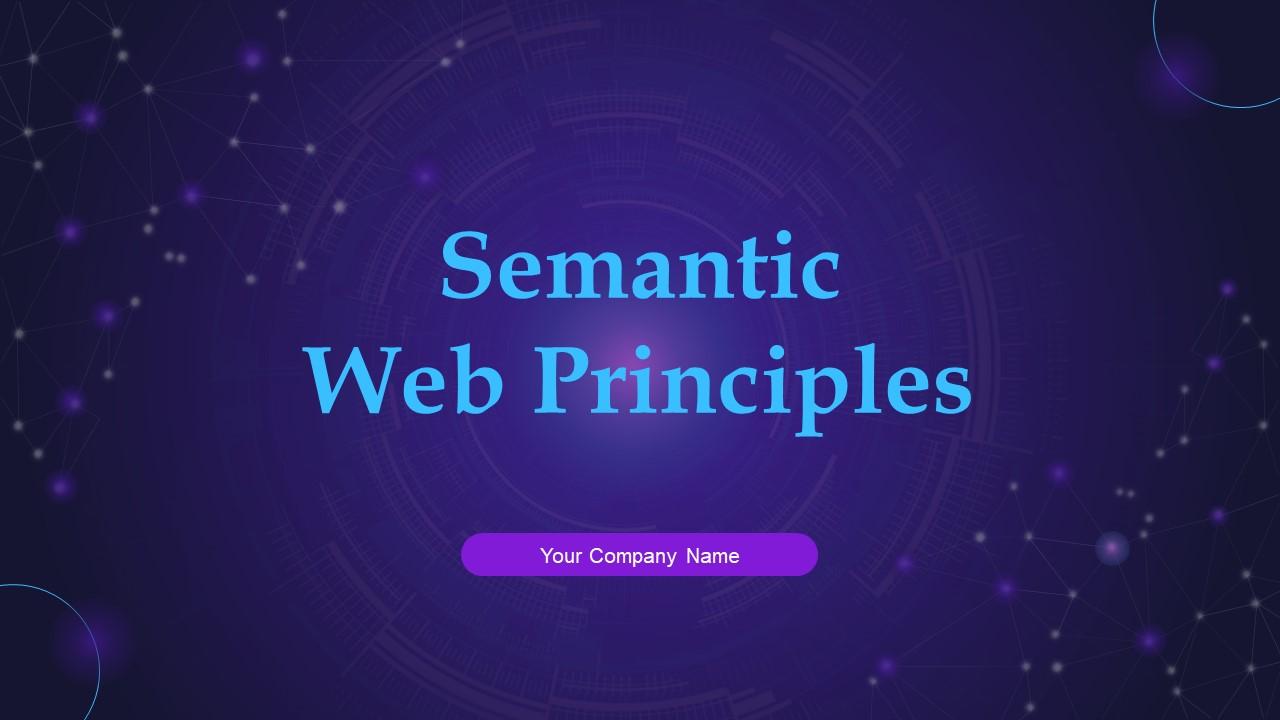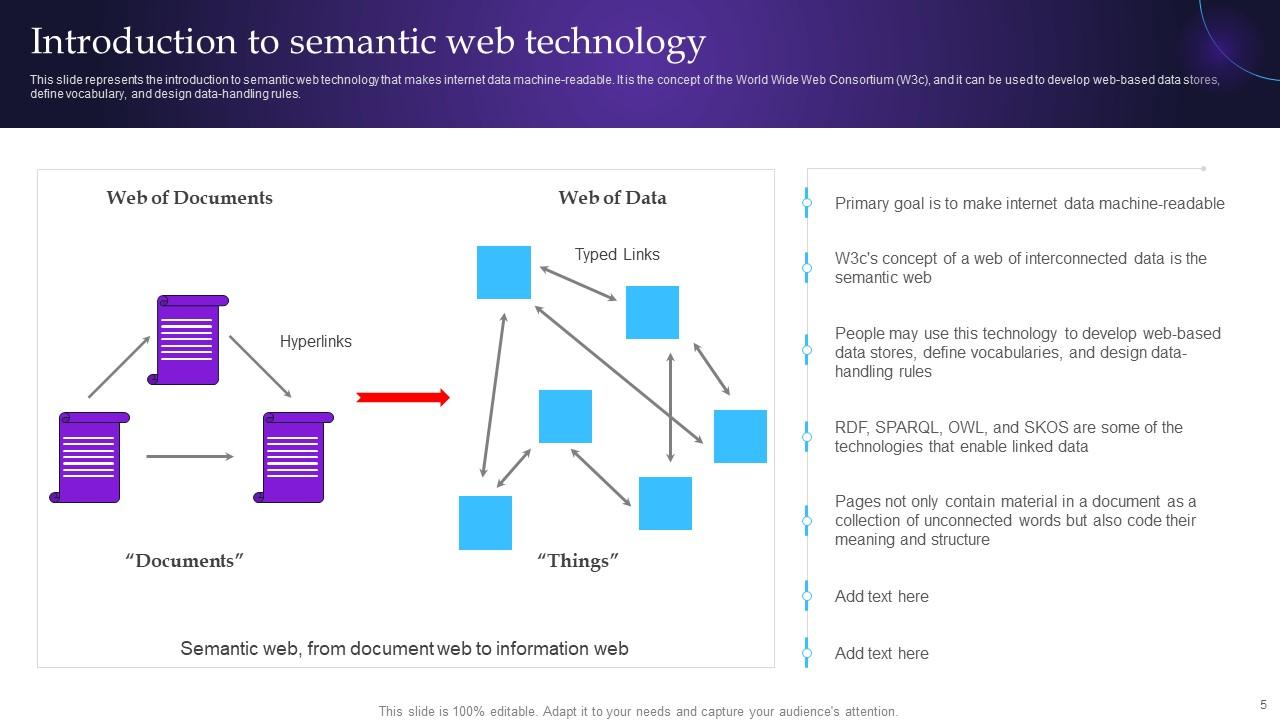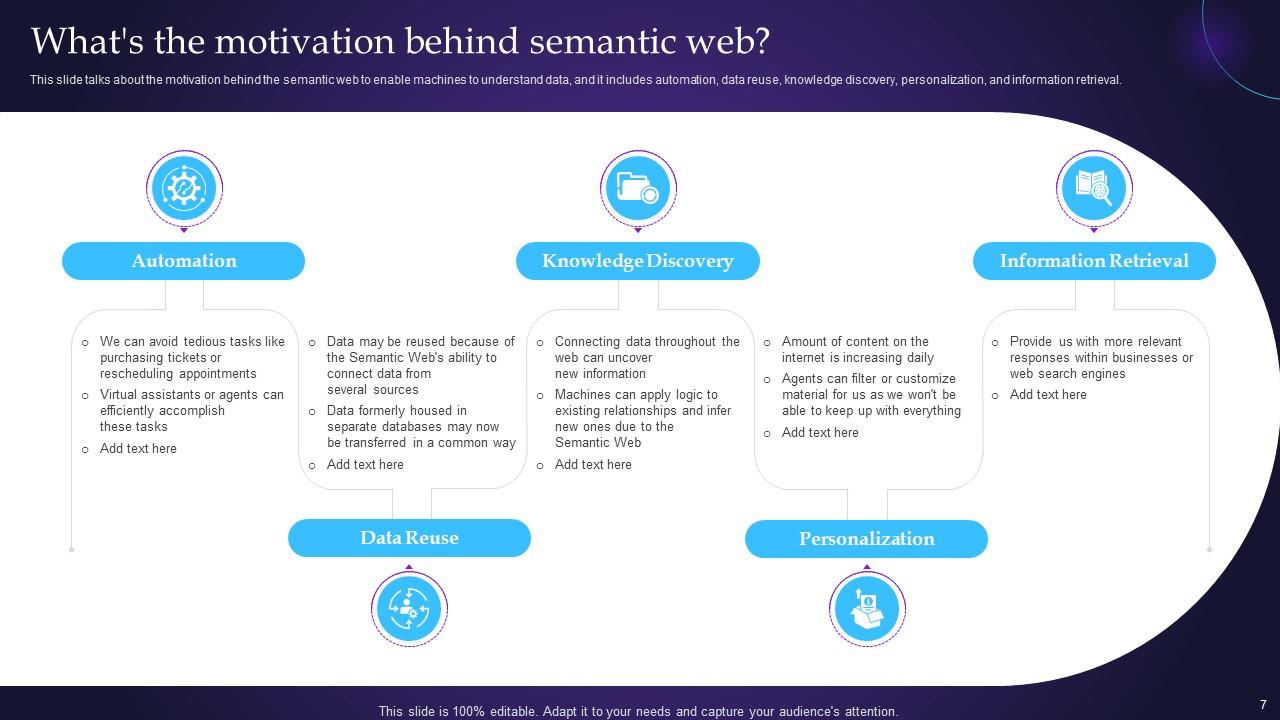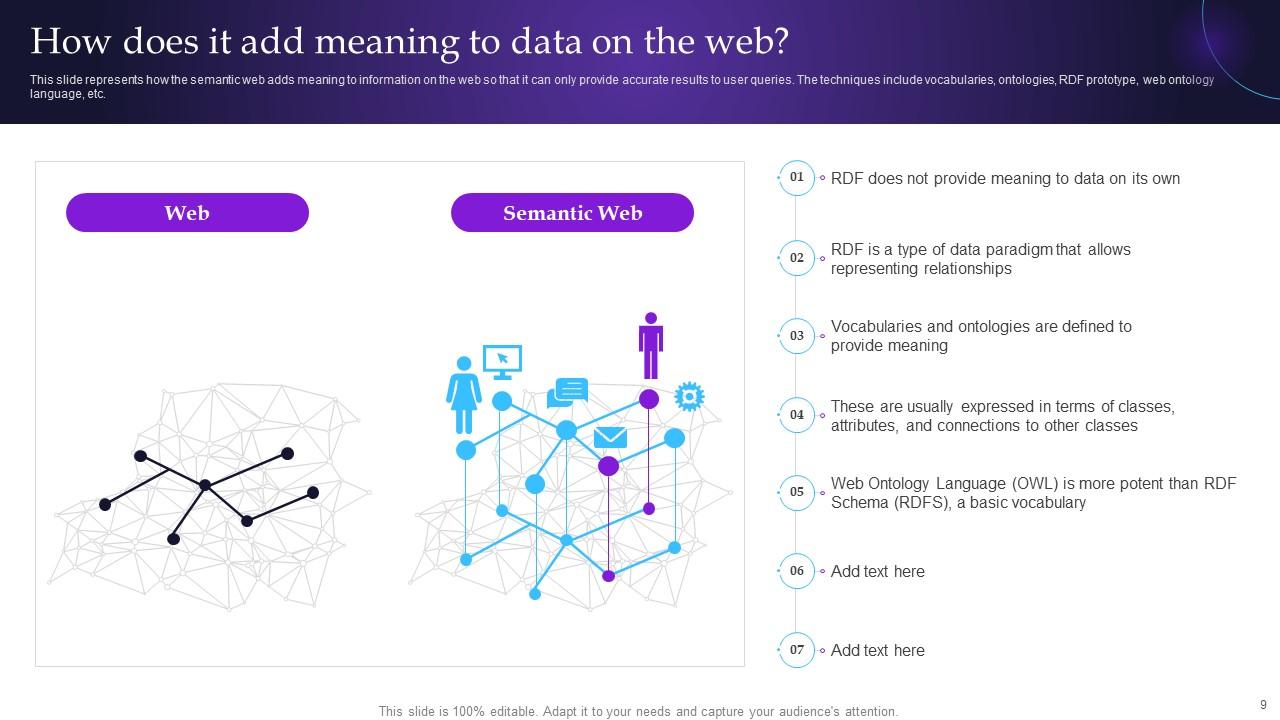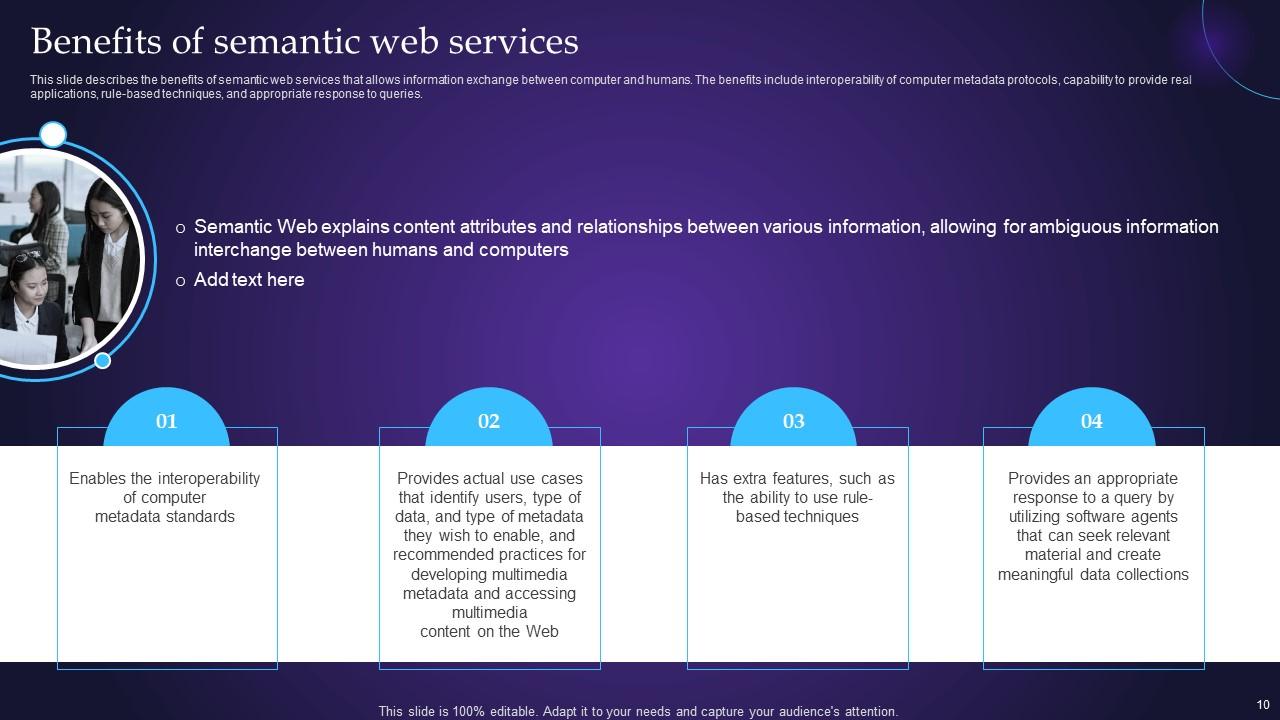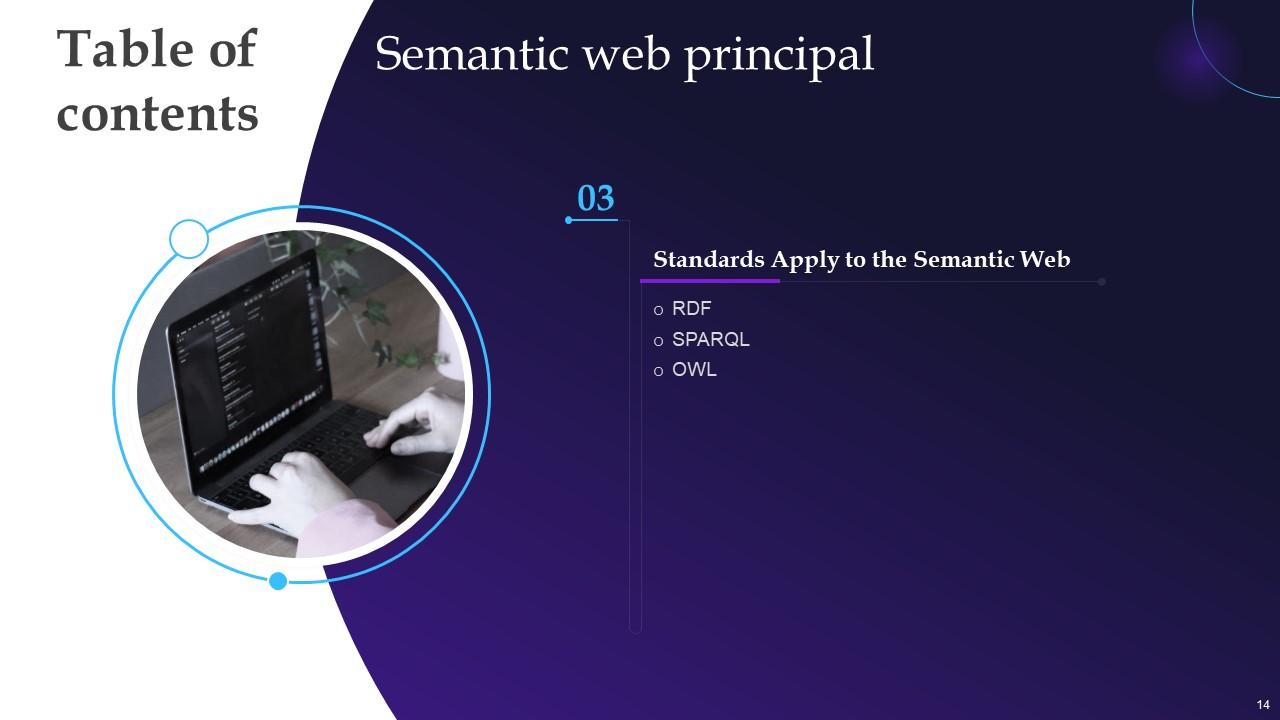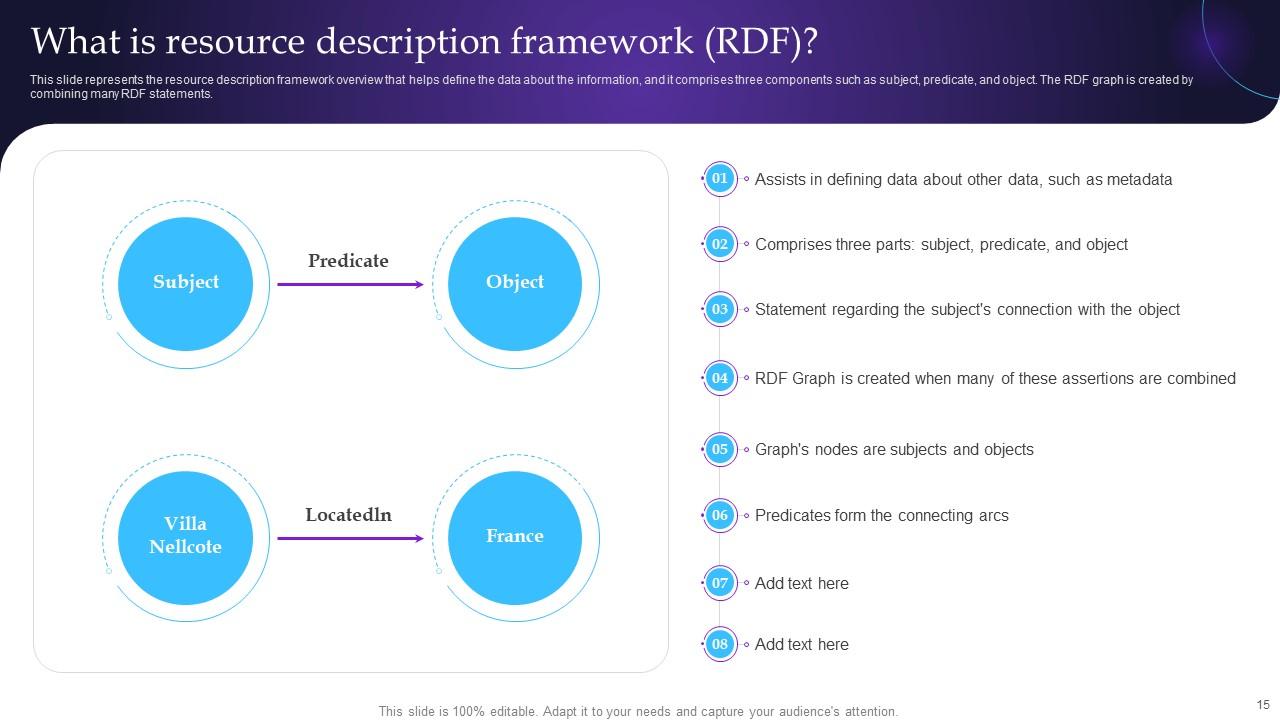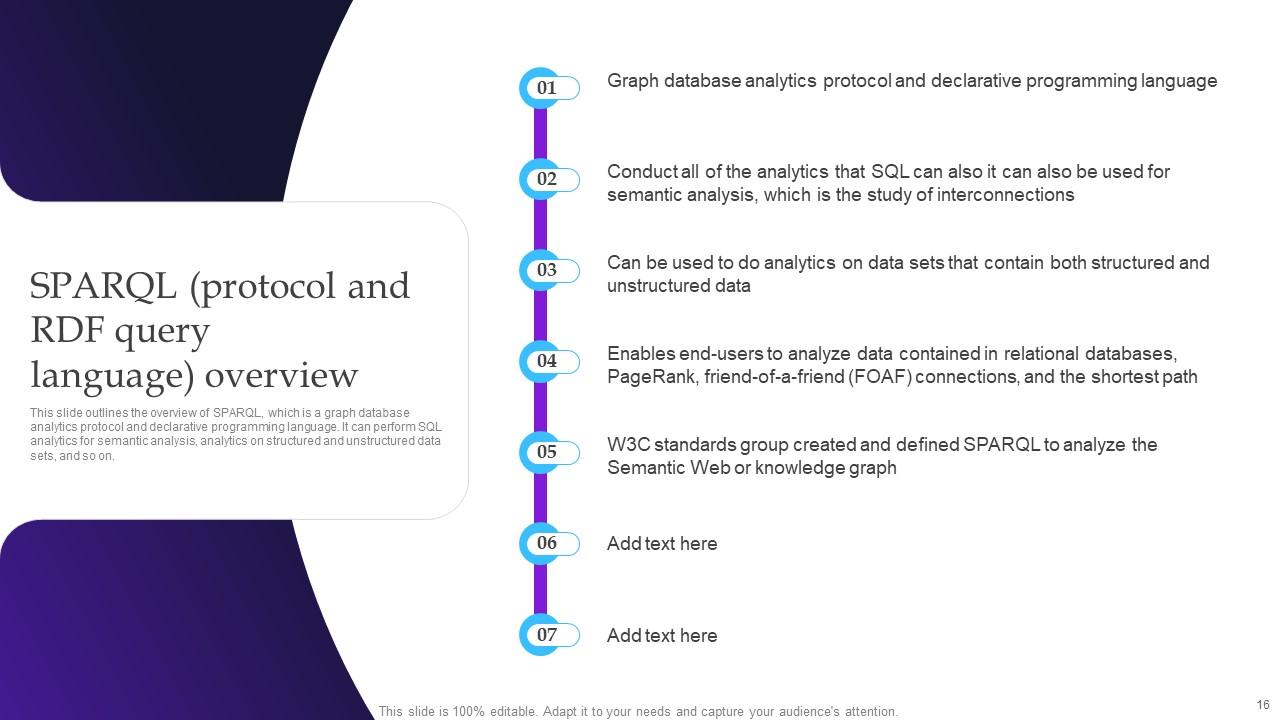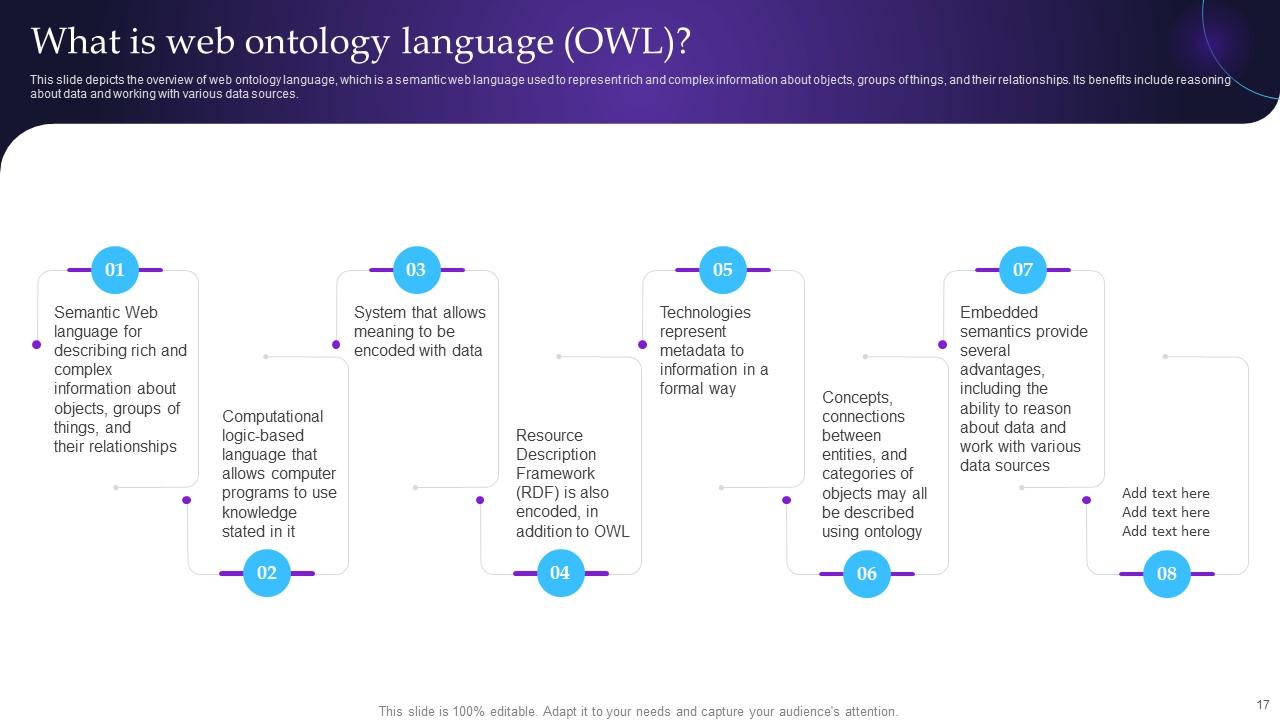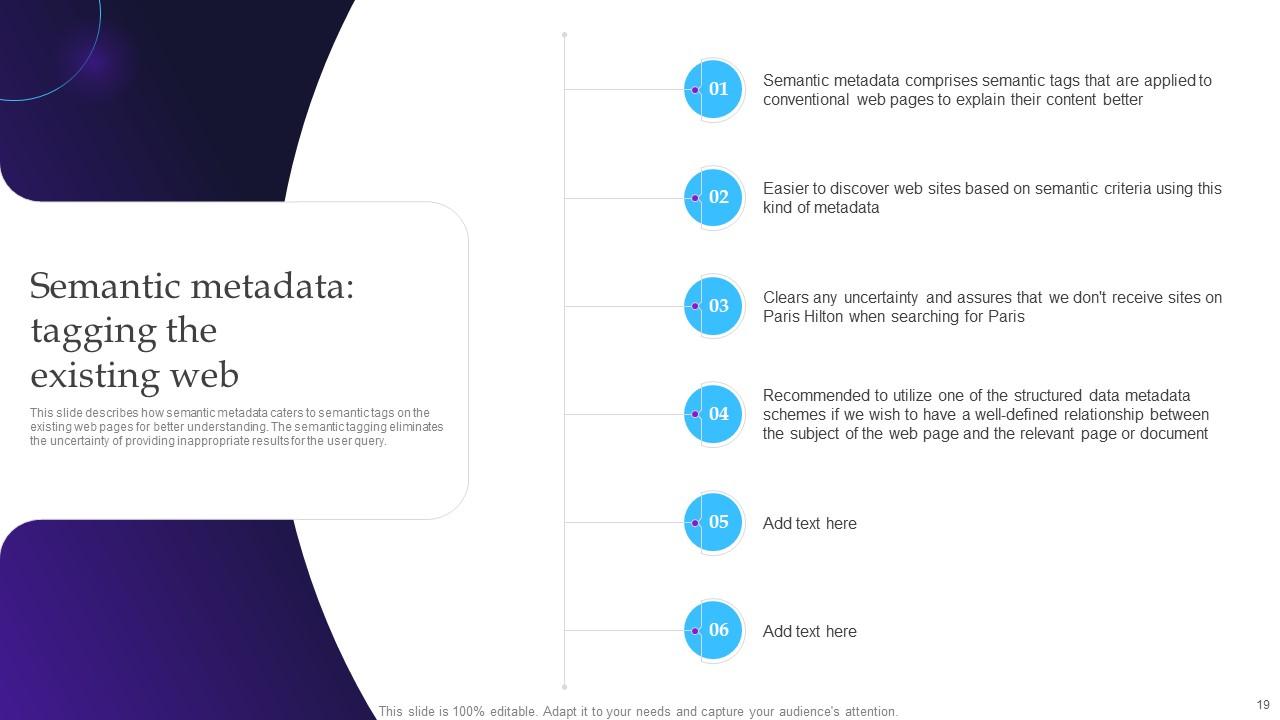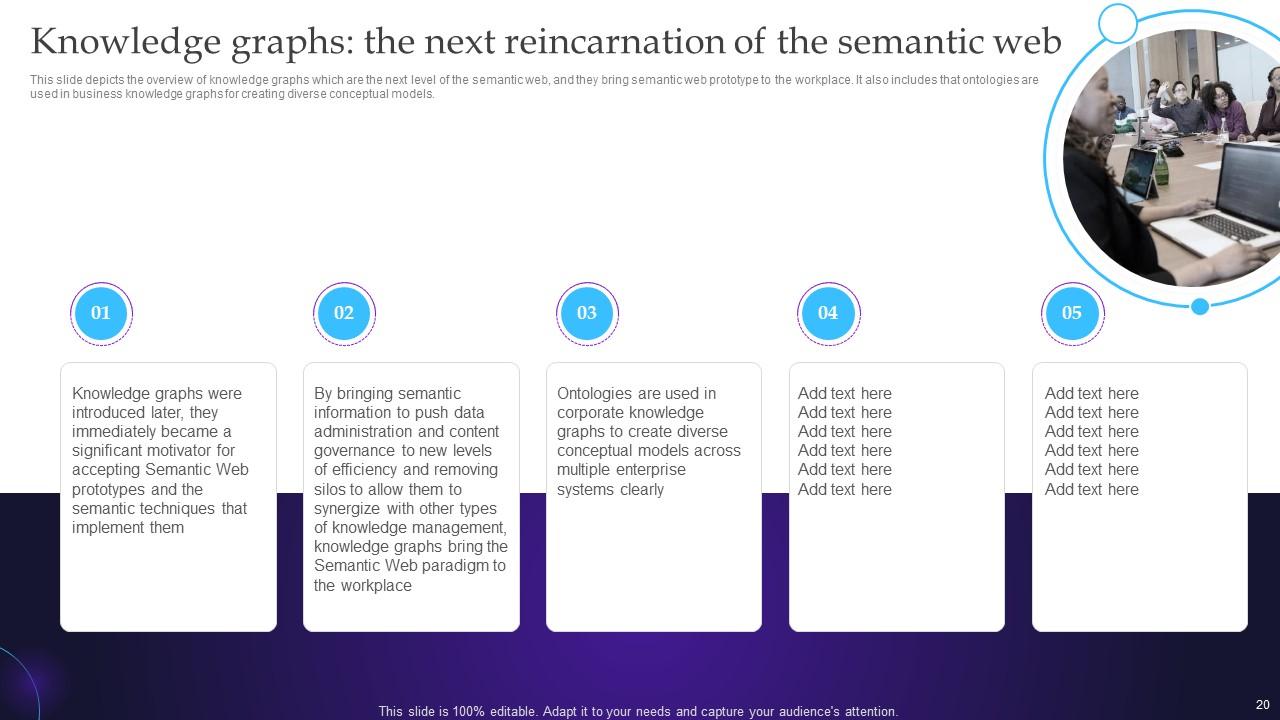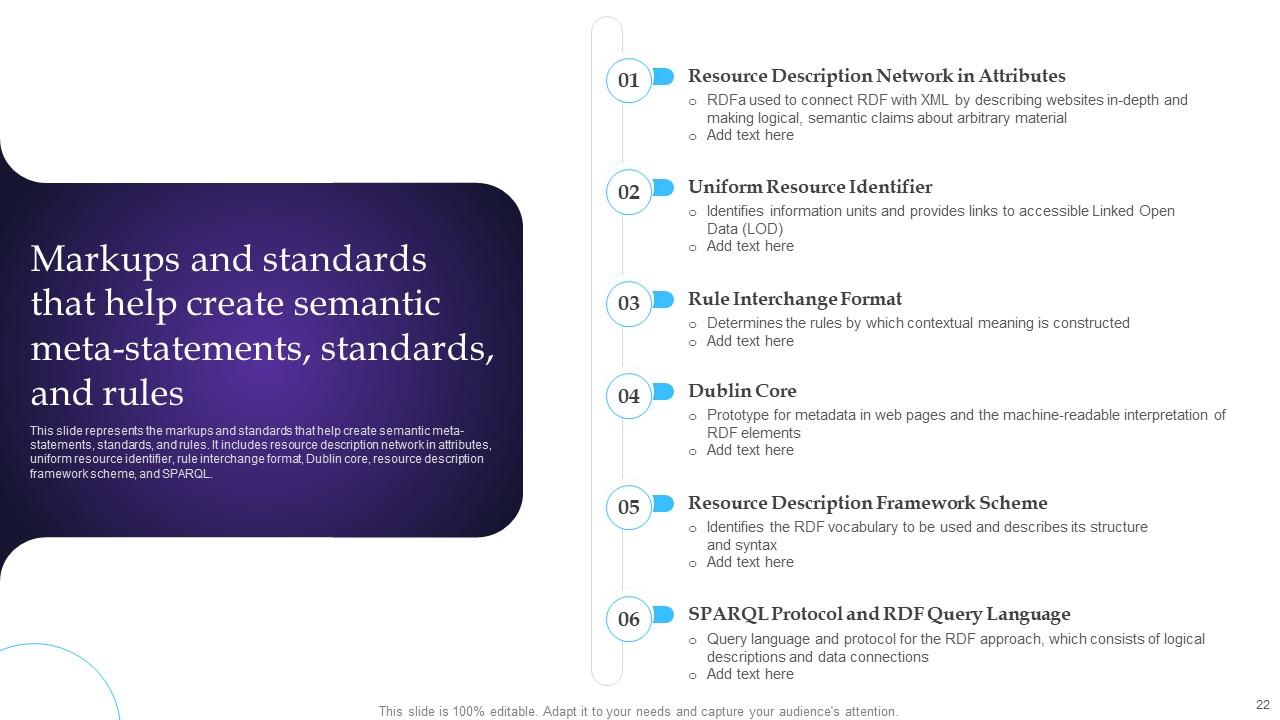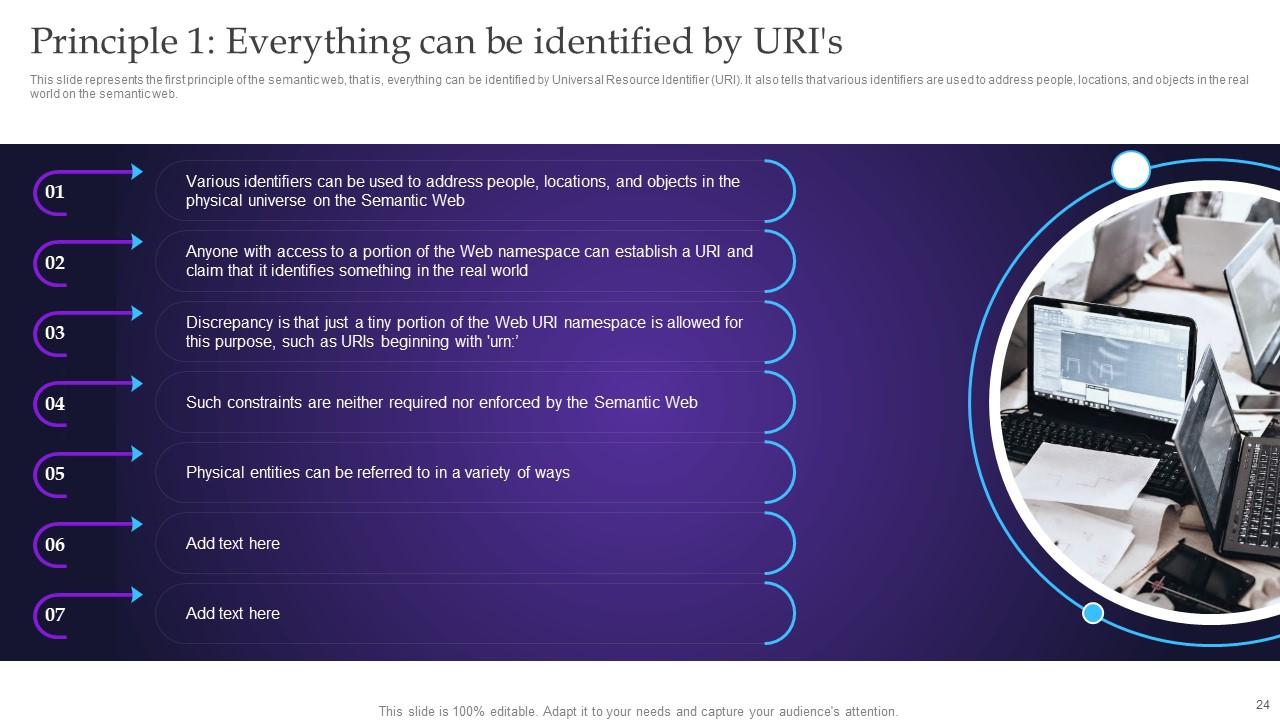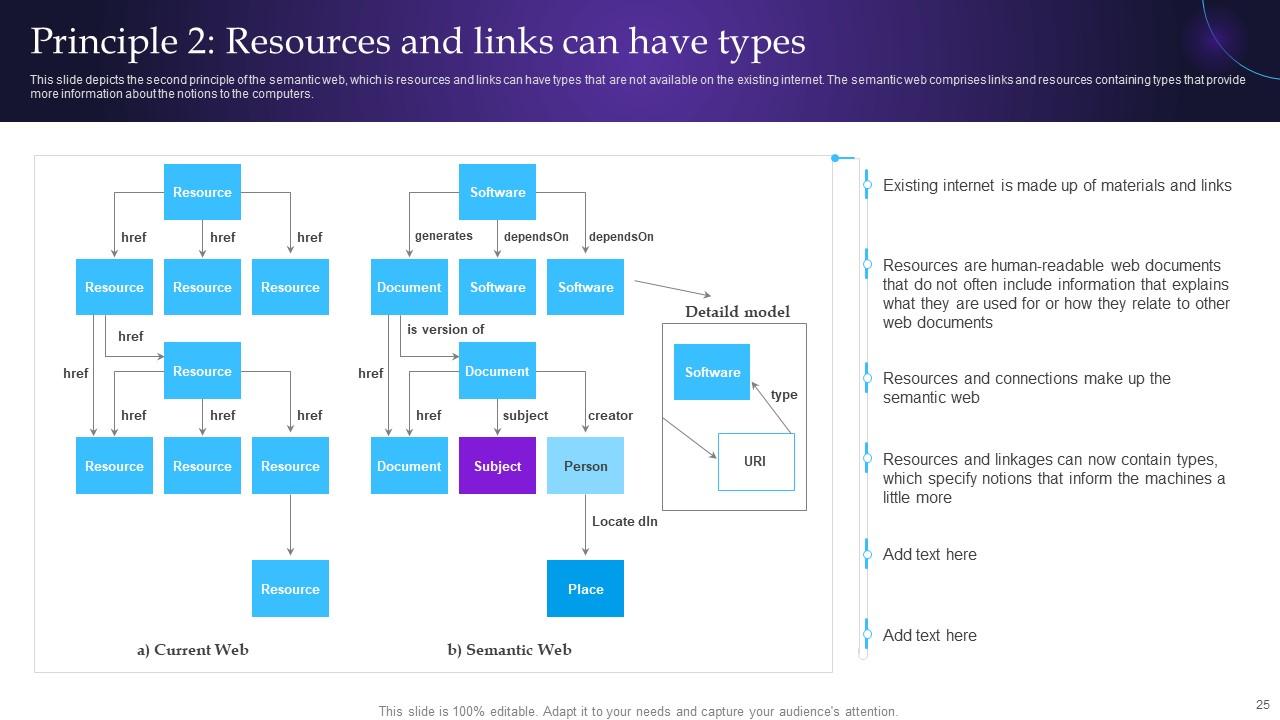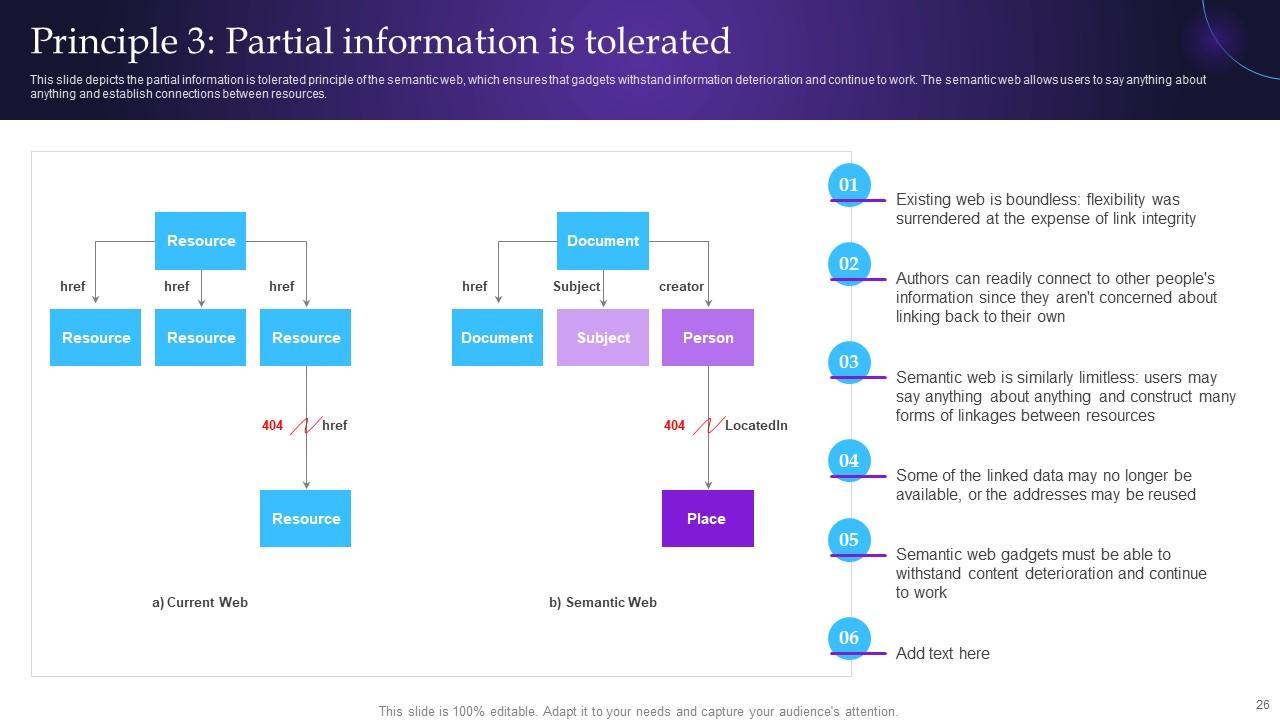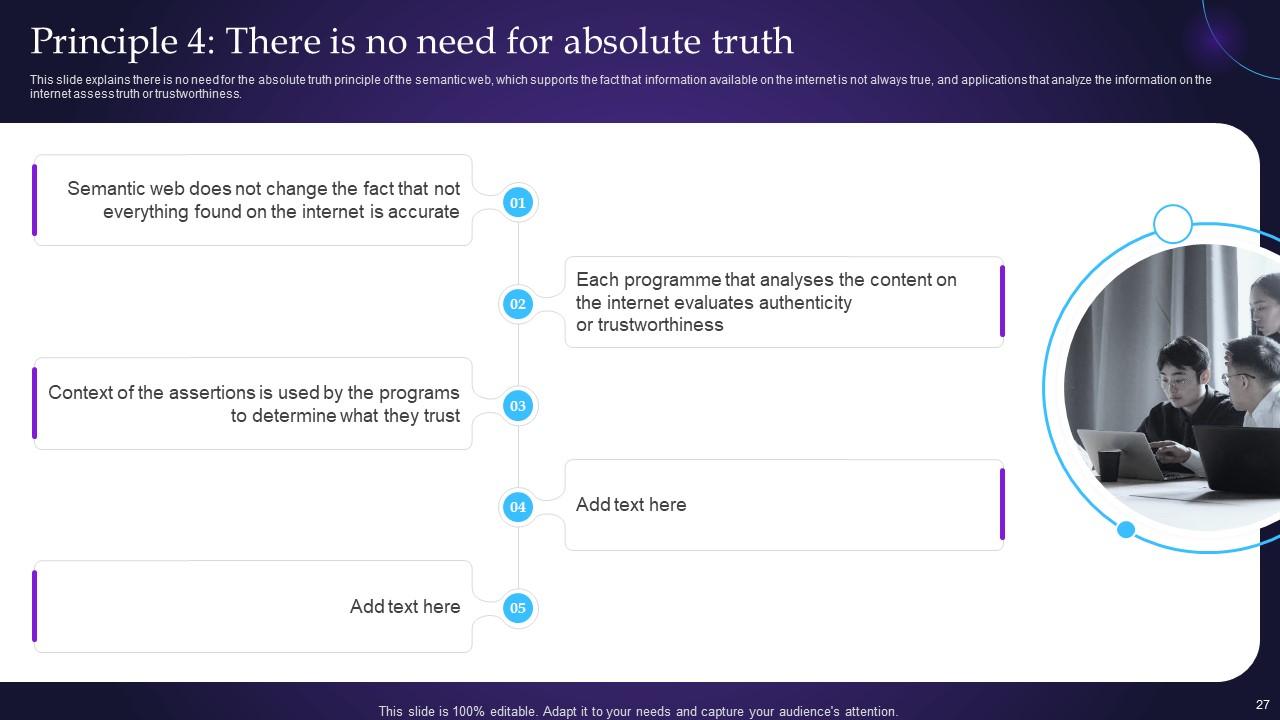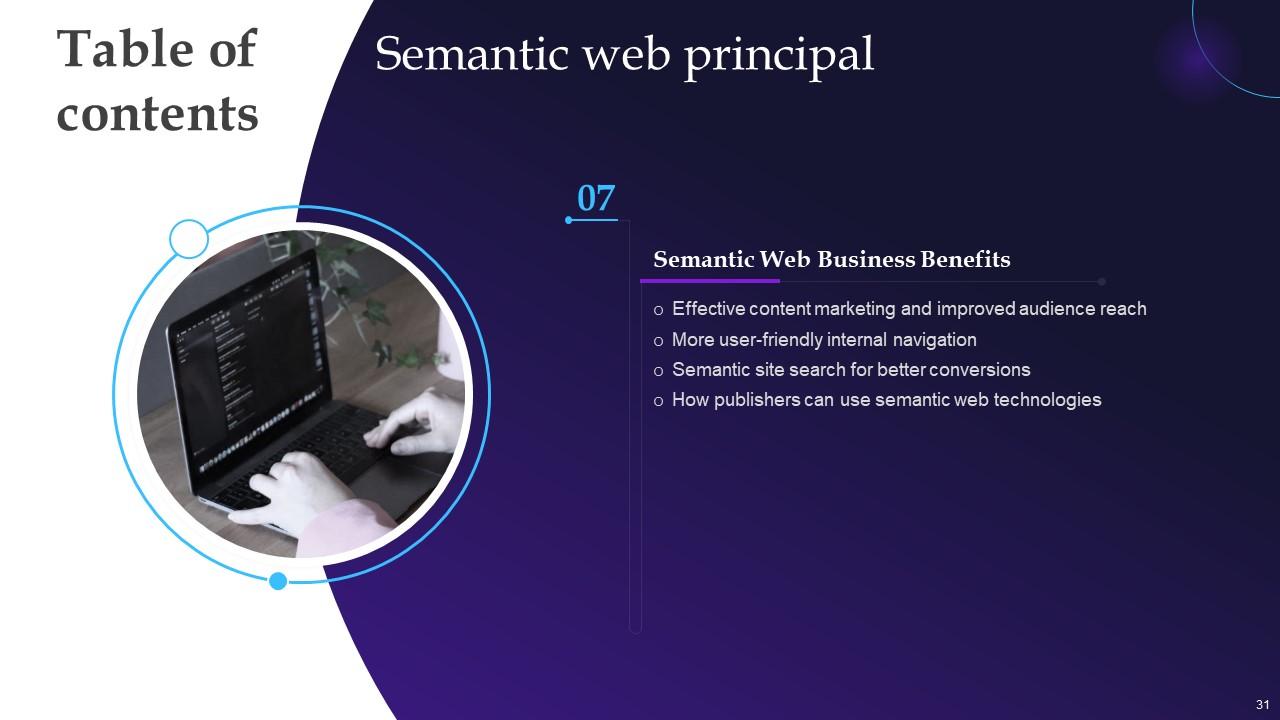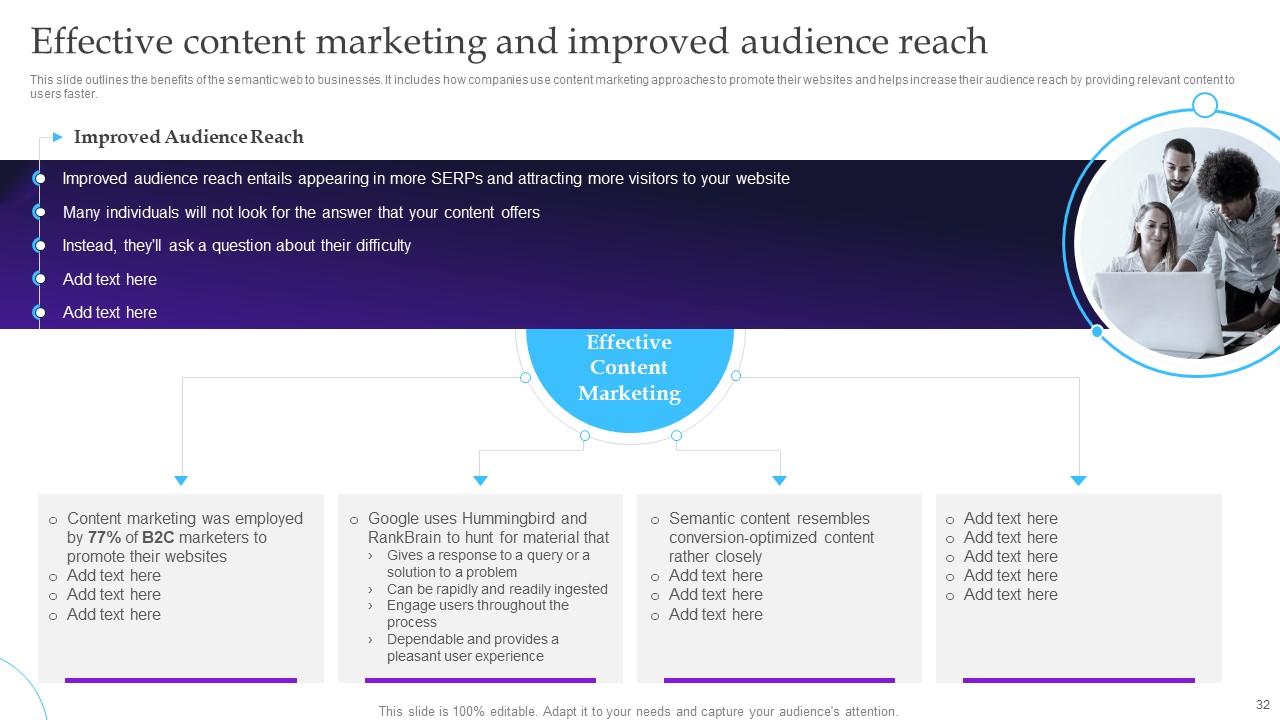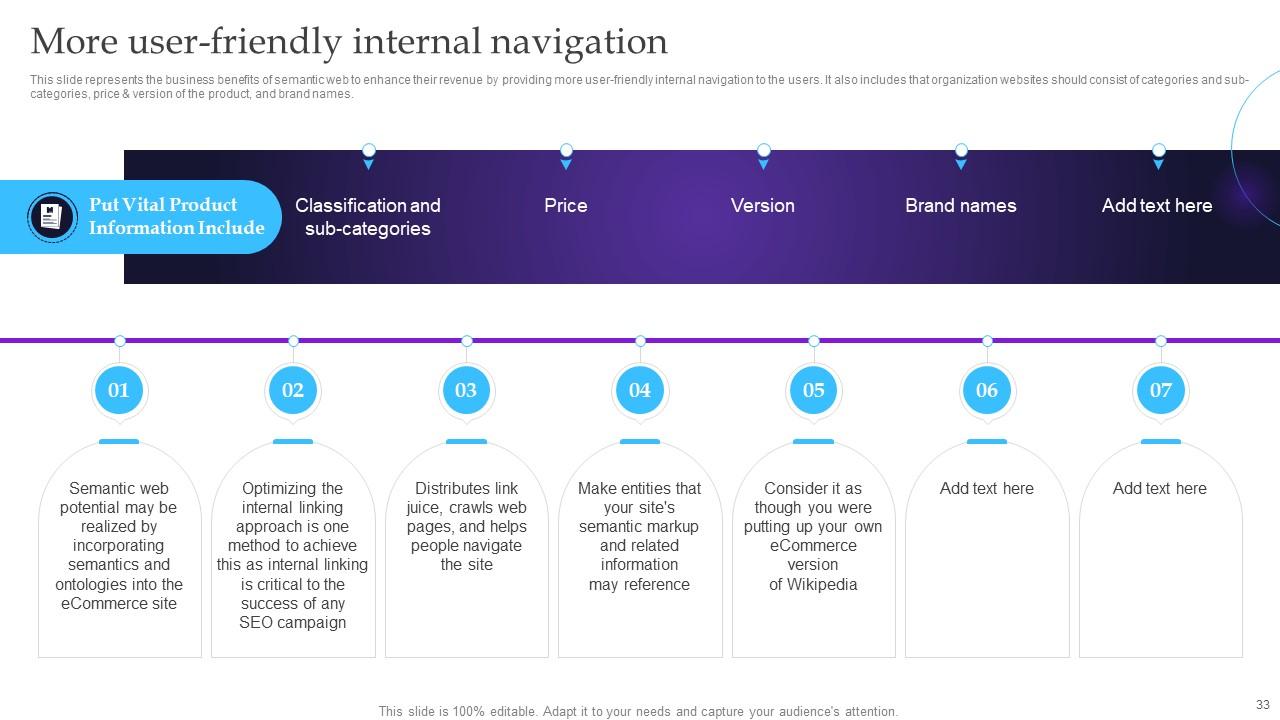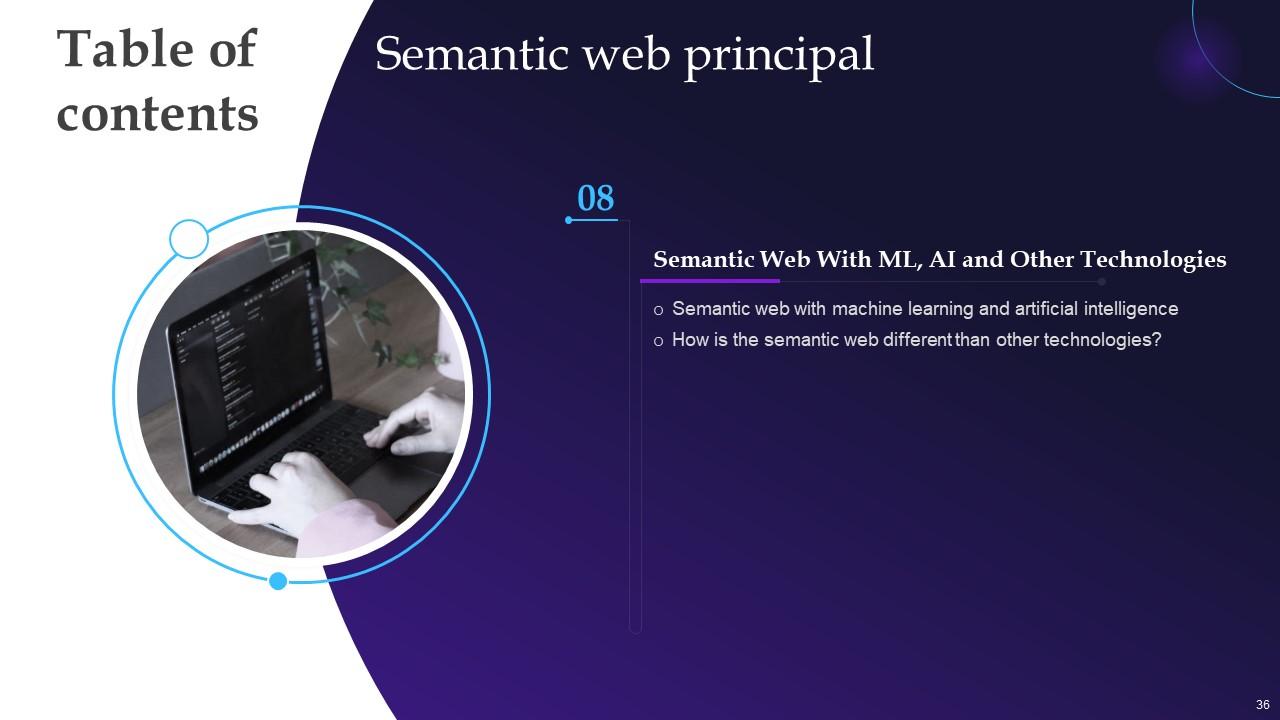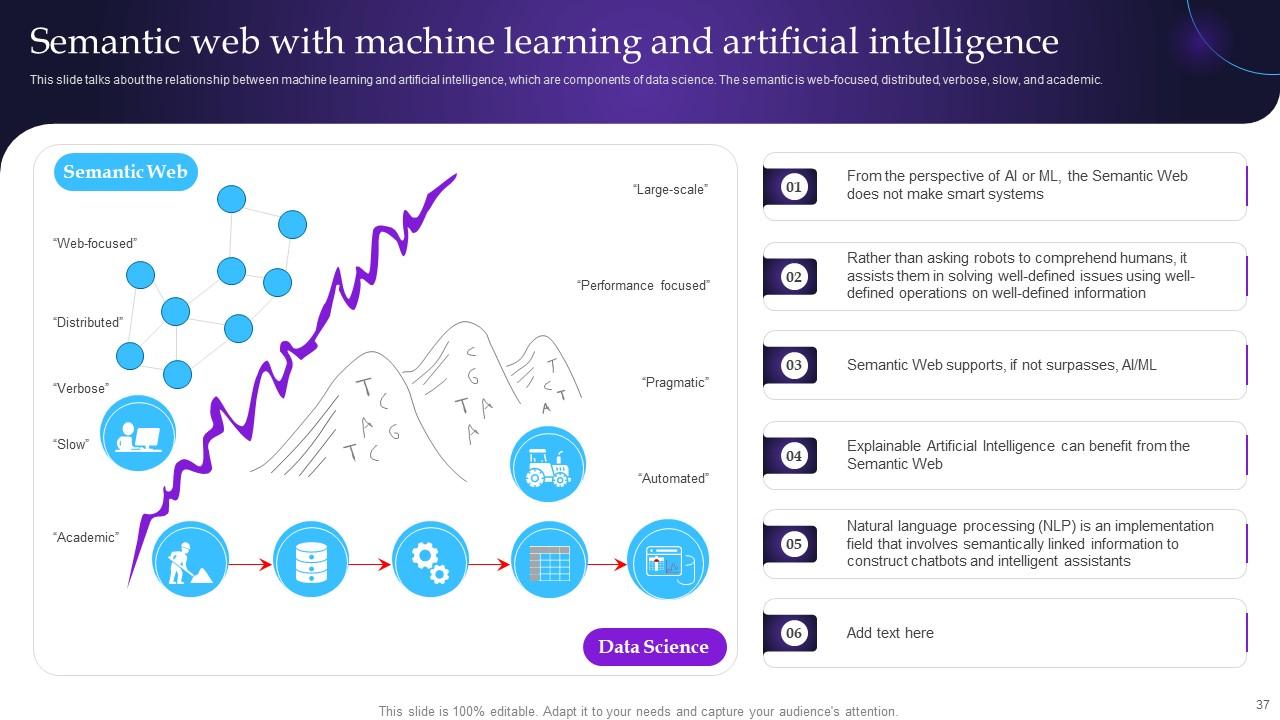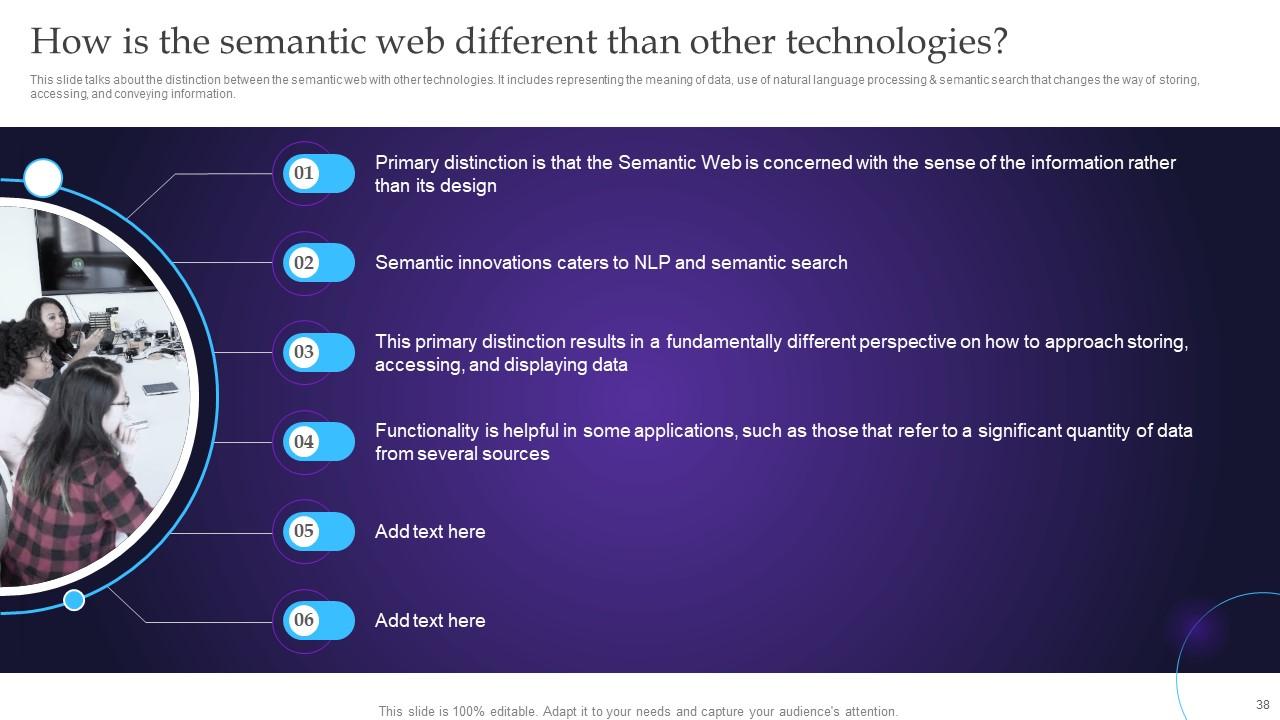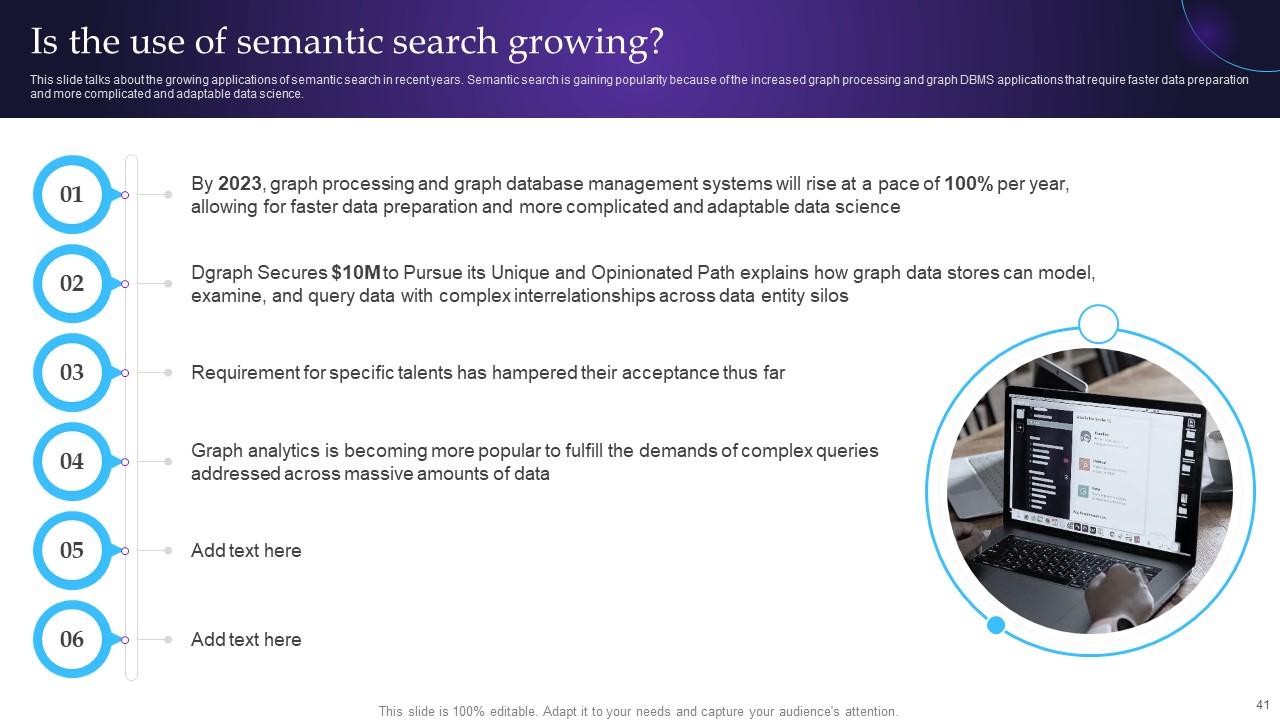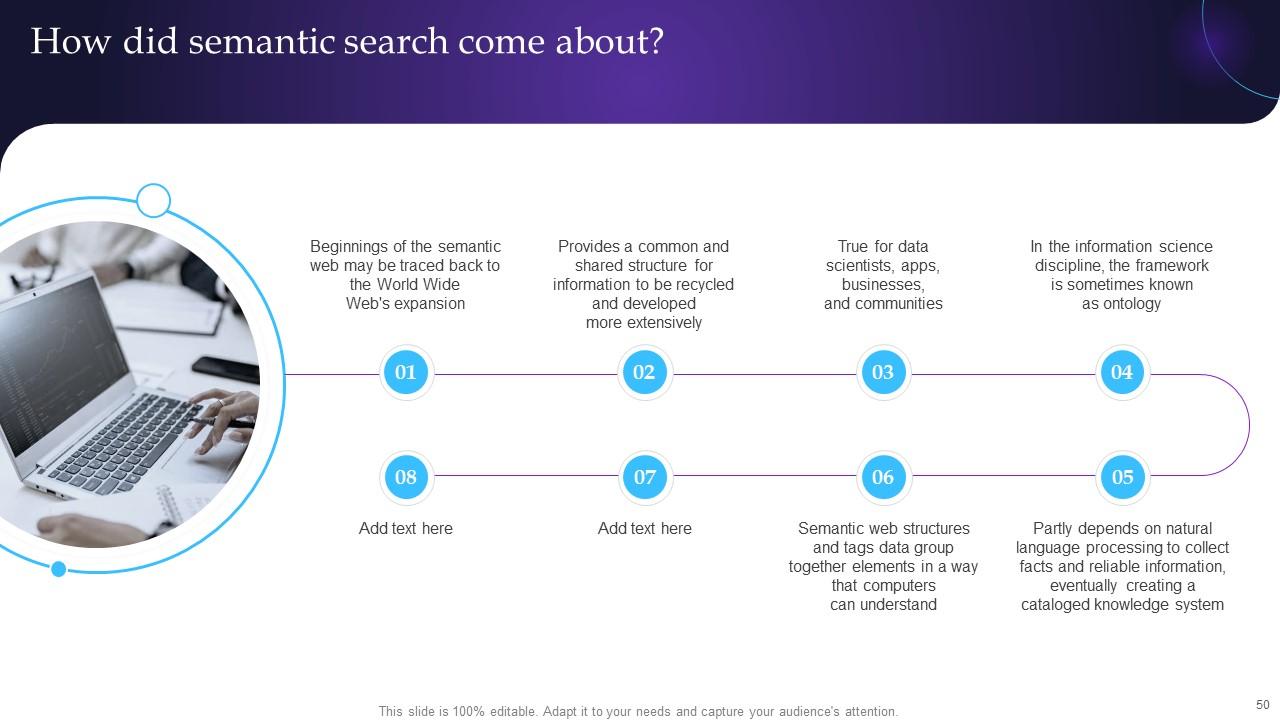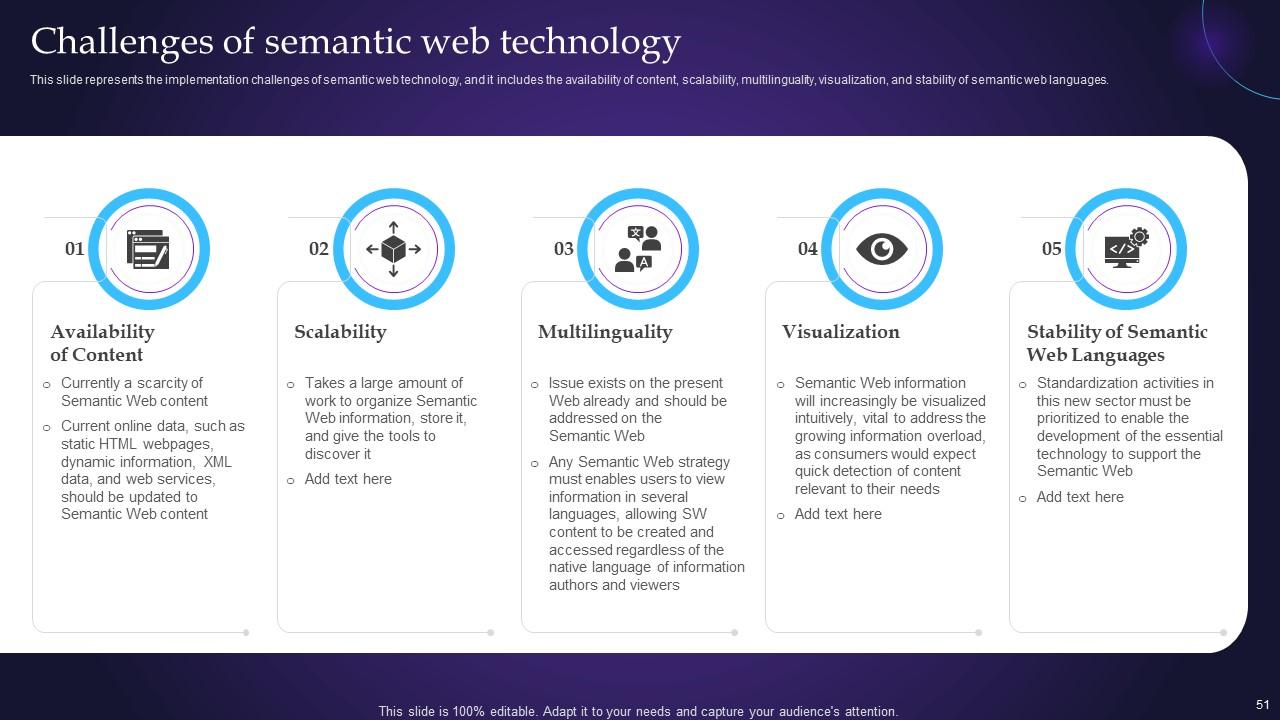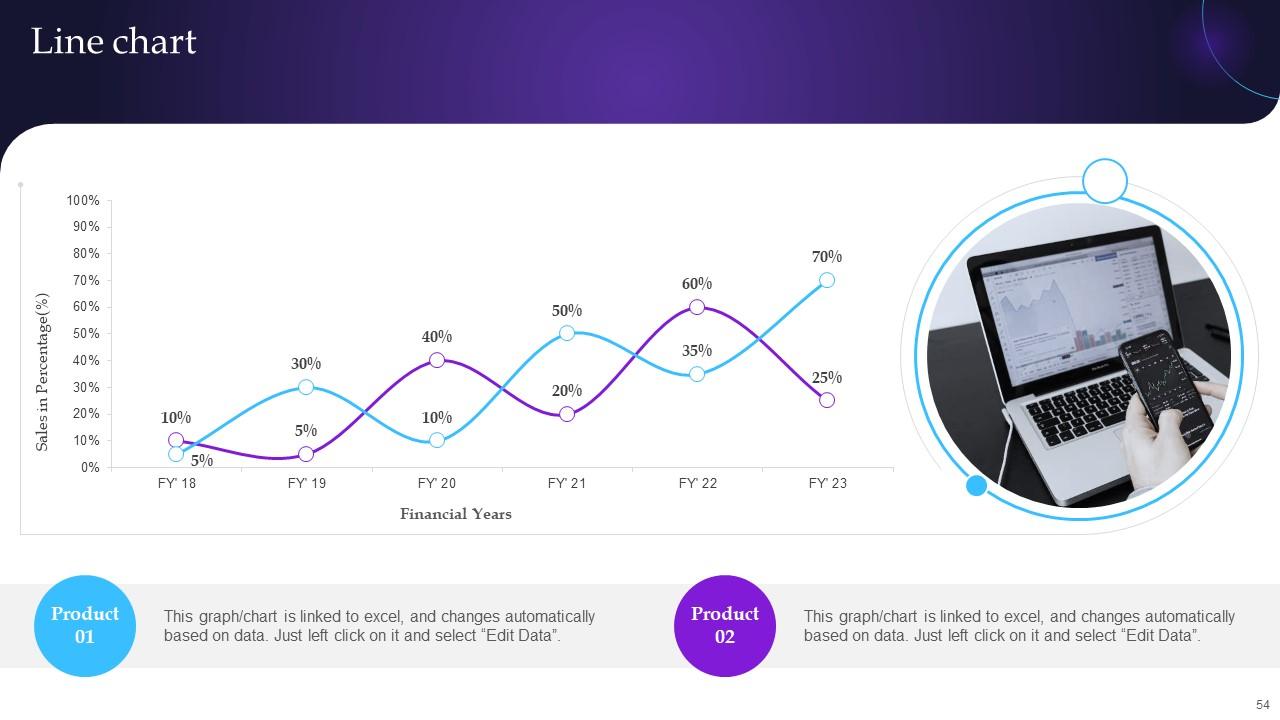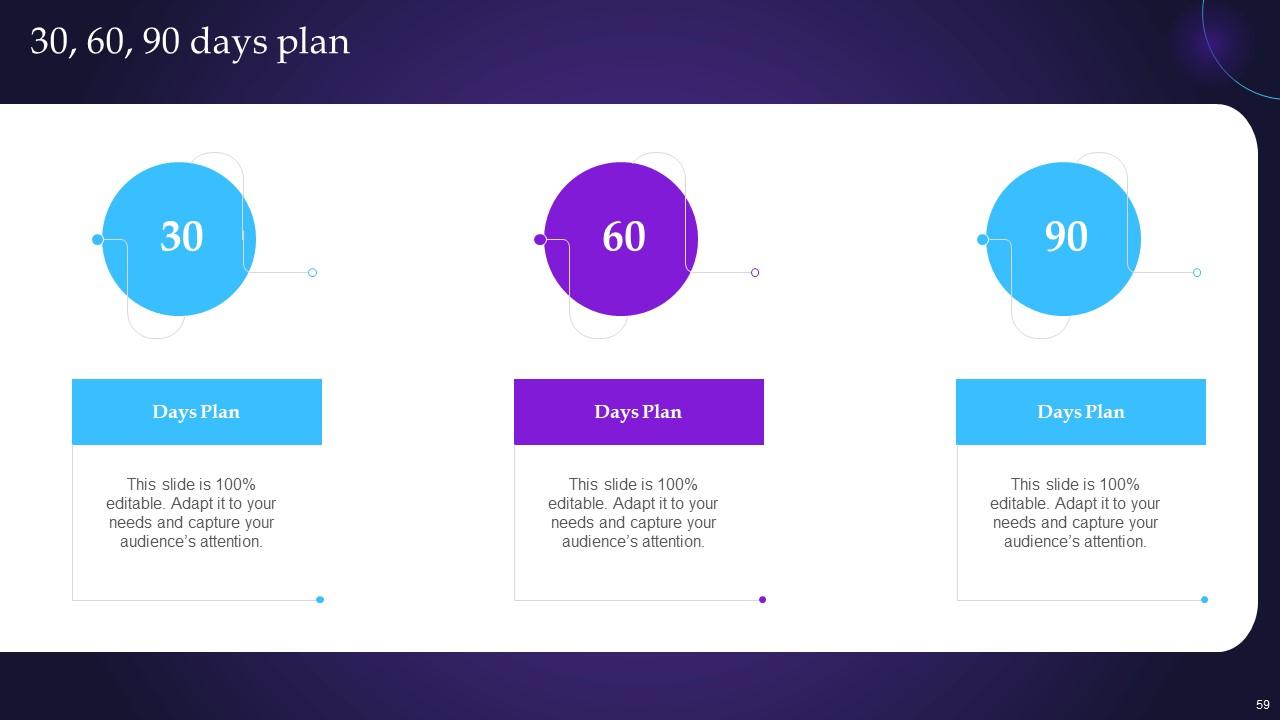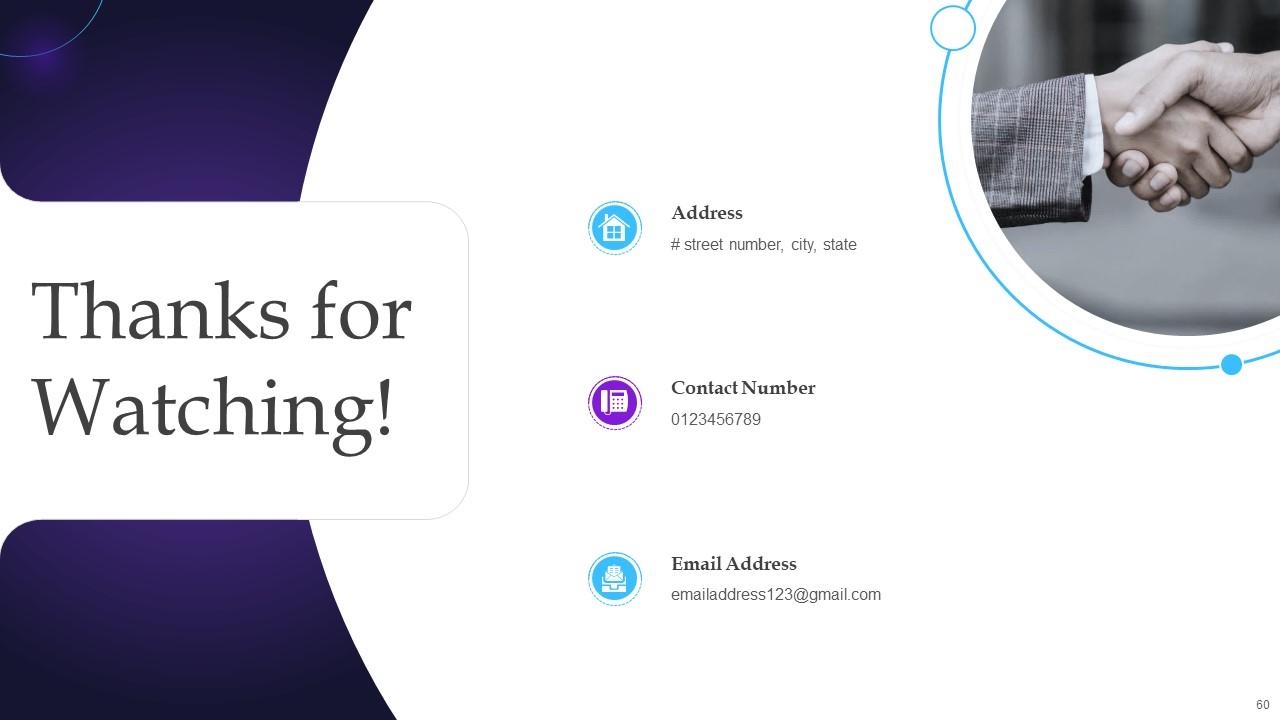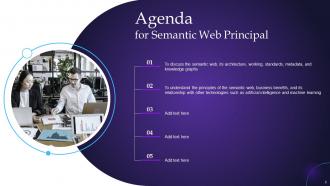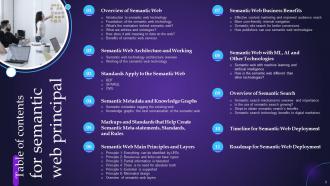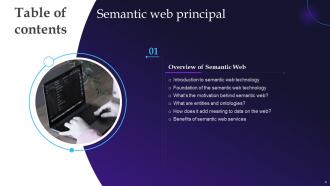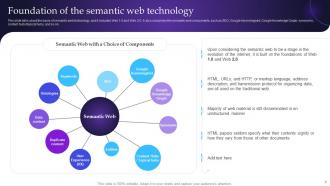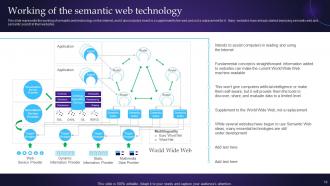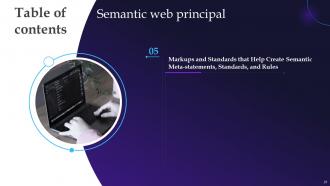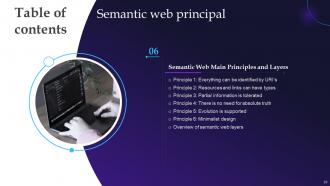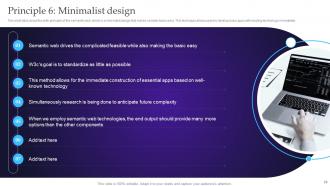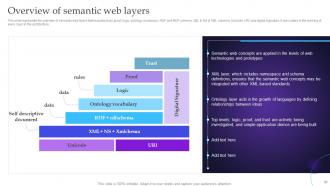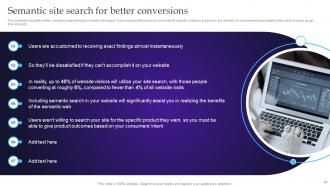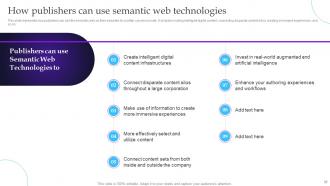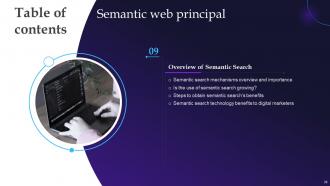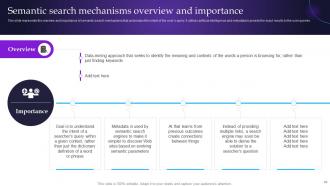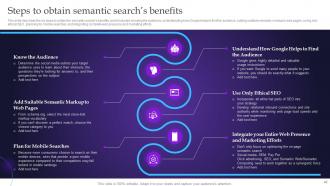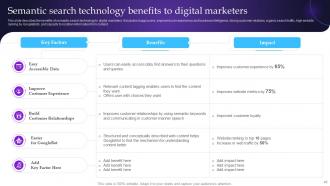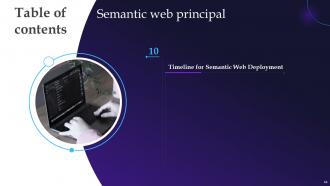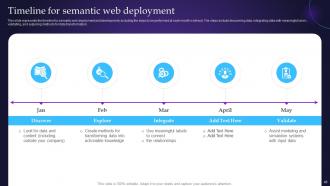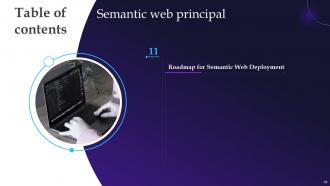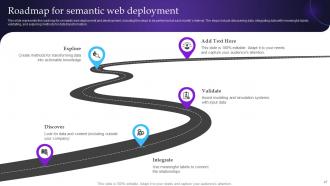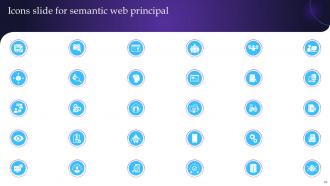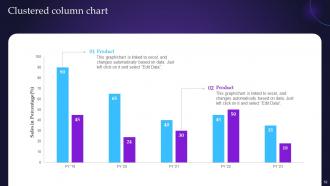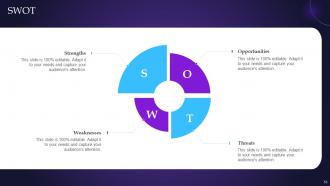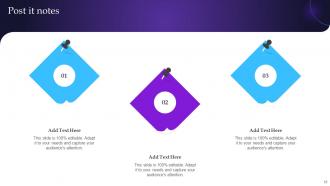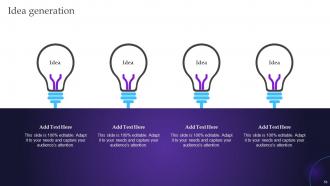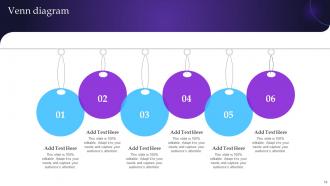Semantic Web Principles Powerpoint Presentation Slides
This PowerPoint presentation briefly overviews the semantic web by covering its introduction, foundation, entities and ontologies, impact, and benefits. In this Semantic Web Principles PowerPoint Presentation, we have covered the semantic web architecture, its working, standards of the semantic web, knowledge graph, and semantic metadata. In addition, this Semantic Web Ontology PPT contains the Markups and standards that help create semantic meta-statements, standards, and rules. Also, the Semantic Web Principles PPT presentation includes the principles and layers, everything that can be identified by URIs, resources, related links and their types, partial information, and so on. Moreover, the Semantic Web Standards deck comprises business benefits of the semantic web, the relationship of the semantic web with Machine Learning, Artificial Intelligence, and other technologies. Furthermore, this Semantic Search template caters to an overview of the semantic search mechanism and importance, the growth of semantic search, steps to obtain semantic searchs benefits, and its advantages to digital marketers. It also includes a timeline and a roadmap for semantic web development. Download our 100 percent editable and customizable template, which is also compatible with Google Slides.
This PowerPoint presentation briefly overviews the semantic web by covering its introduction, foundation, entities and onto..
- Google Slides is a new FREE Presentation software from Google.
- All our content is 100% compatible with Google Slides.
- Just download our designs, and upload them to Google Slides and they will work automatically.
- Amaze your audience with SlideTeam and Google Slides.
-
Want Changes to This PPT Slide? Check out our Presentation Design Services
- WideScreen Aspect ratio is becoming a very popular format. When you download this product, the downloaded ZIP will contain this product in both standard and widescreen format.
-

- Some older products that we have may only be in standard format, but they can easily be converted to widescreen.
- To do this, please open the SlideTeam product in Powerpoint, and go to
- Design ( On the top bar) -> Page Setup -> and select "On-screen Show (16:9)” in the drop down for "Slides Sized for".
- The slide or theme will change to widescreen, and all graphics will adjust automatically. You can similarly convert our content to any other desired screen aspect ratio.
Compatible With Google Slides

Get This In WideScreen
You must be logged in to download this presentation.
PowerPoint presentation slides
Enthrall your audience with this Semantic Web Principles Powerpoint Presentation Slides. Increase your presentation threshold by deploying this well-crafted template. It acts as a great communication tool due to its well-researched content. It also contains stylized icons, graphics, visuals etc, which make it an immediate attention-grabber. Comprising sixty slides, this complete deck is all you need to get noticed. All the slides and their content can be altered to suit your unique business setting. Not only that, other components and graphics can also be modified to add personal touches to this prefabricated set.
People who downloaded this PowerPoint presentation also viewed the following :
Content of this Powerpoint Presentation
Slide 1: This slide introduces Semantic Web Principles. State your company name and begin.
Slide 2: This slide states Agenda of the presentation.
Slide 3: This slide shows Table of Content for the presentation.
Slide 4: This slide highlights title for topics that are to be covered next in the template.
Slide 5: This slide represents the introduction to semantic web technology that makes internet data machine-readable.
Slide 6: This slide talks about the basis of semantic web technology, and it includes Web 1.0 and Web 2.0.
Slide 7: This slide talks about the motivation behind the semantic web to enable machines to understand data.
Slide 8: This slide gives an overview of entities and ontologies, including their importance to the semantic web.
Slide 9: This slide represents how the semantic web adds meaning to information on the web so that it can only provide accurate results to user queries.
Slide 10: This slide describes the benefits of semantic web services that allows information exchange between computer and humans.
Slide 11: This slide highlights title for topics that are to be covered next in the template.
Slide 12: This slide represents the semantic web technology architecture overview by showcasing various layers of it.
Slide 13: This slide represents the working of semantic web technology on the internet, and it also includes how it is a supplement to the web and not a replacement for it.
Slide 14: This slide highlights title for topics that are to be covered next in the template.
Slide 15: This slide represents the resource description framework overview that helps define the data about the information.
Slide 16: This slide outlines the overview of SPARQL, which is a graph database analytics protocol and declarative programming language.
Slide 17: This slide depicts the overview of web ontology language.
Slide 18: This slide highlights title for topics that are to be covered next in the template.
Slide 19: This slide describes how semantic metadata caters to semantic tags on the existing web pages for better understanding.
Slide 20: This slide depicts the overview of knowledge graphs which are the next level of the semantic web, and they bring semantic web prototype to the workplace.
Slide 21: This slide highlights title for topics that are to be covered next in the template.
Slide 22: This slide represents the markups and standards that help create semantic meta-statements, standards, and rules.
Slide 23: This slide highlights title for topics that are to be covered next in the template.
Slide 24: This slide represents the first principle of the semantic web, that is, everything can be identified by Universal Resource Identifier (URI).
Slide 25: This slide depicts the second principle of the semantic web, which is resources and links can have types that are not available on the existing internet.
Slide 26: This slide depicts the partial information is tolerated principle of the semantic web.
Slide 27: This slide explains there is no need for the absolute truth principle of the semantic web.
Slide 28: This slide represents the fifth principle of the semantic web that is evolution is supported and provides tools to eliminate ambiguities and resolve discrepancies.
Slide 29: This slide talks about the sixth principle of the semantic web, which is a minimalist design that makes complex tasks easy.
Slide 30: This slide represents the overview of semantic web layers.
Slide 31: This slide highlights title for topics that are to be covered next in the template.
Slide 32: This slide outlines the benefits of the semantic web to businesses.
Slide 33: This slide represents the business benefits of semantic web to enhance their revenue by providing more user-friendly internal navigation to the users.
Slide 34: This slide talks about the better conversion rates through semantic site search.
Slide 35: This slide represents how publishers can use the semantic web on their websites for a better conversion rate.
Slide 36: This slide highlights title for topics that are to be covered next in the template.
Slide 37: This slide talks about the relationship between machine learning and artificial intelligence, which are components of data science.
Slide 38: This slide talks about the distinction between the semantic web with other technologies.
Slide 39: This slide highlights title for topics that are to be covered next in the template.
Slide 40: This slide represents the overview and importance of semantic search mechanisms that understand the intent of the user’s query.
Slide 41: This slide talks about the growing applications of semantic search in recent years.
Slide 42: This slide describes the six steps to obtain the semantic search’s benefits.
Slide 43: This slide describes the benefits of semantic search technology to digital marketers.
Slide 44: This slide highlights title for topics that are to be covered next in the template.
Slide 45: This slide represents the timeline for semantic web deployment and development, including the steps to be performed at each month’s interval.
Slide 46: This slide highlights title for topics that are to be covered next in the template.
Slide 47: This slide represents the roadmap for semantic web deployment and development, including the steps to be performed at each month’s interval.
Slide 48: This slide contains all the icons used in this presentation.
Slide 49: This slide is titled as Additional Slides for moving forward.
Slide 50: This slide display How did semantic search come about?
Slide 51: This slide represents the implementation challenges of semantic web technology.
Slide 52: This slide provides Clustered Column chart with two products comparison.
Slide 53: This slide shows SWOT describing- Strength, Weakness, Opportunity, and Threat.
Slide 54: This slide describes Line chart with two products comparison.
Slide 55: This slide shows Post It Notes. Post your important notes here.
Slide 56: This is an Idea Generation slide to state a new idea or highlight information, specifications etc.
Slide 57: This slide contains Puzzle with related icons and text.
Slide 58: This slide depicts Venn diagram with text boxes.
Slide 59: This slide provides 30 60 90 Days Plan with text boxes.
Slide 60: This is a Thank You slide with address, contact numbers and email address.
Semantic Web Principles Powerpoint Presentation Slides with all 65 slides:
Use our Semantic Web Principles Powerpoint Presentation Slides to effectively help you save your valuable time. They are readymade to fit into any presentation structure.
FAQs
The semantic web is a technology that makes internet data machine-readable, allowing machines to understand the meaning of data and provide accurate results to user queries.
The semantic web was developed to enable machines to understand and interpret web data, making it easier to organize and search for information.
Entities are objects or concepts that have a distinct identity, while ontologies are a way to describe entities and their relationships. They are important to the semantic web because they provide a common vocabulary for organizing and interpreting data.
The resource description framework is a standard for describing data and metadata on the web. It allows information to be organized and categorized in a machine-readable way.
Semantic search technology can understand the intent of a user’s query, providing more relevant and accurate results. It can also improve conversion rates for businesses and enhance user experience.
-
Mesmerized with the fantastic collection! Super sleek, relevant infographics.
-
Enough space for editing and adding your own content.


